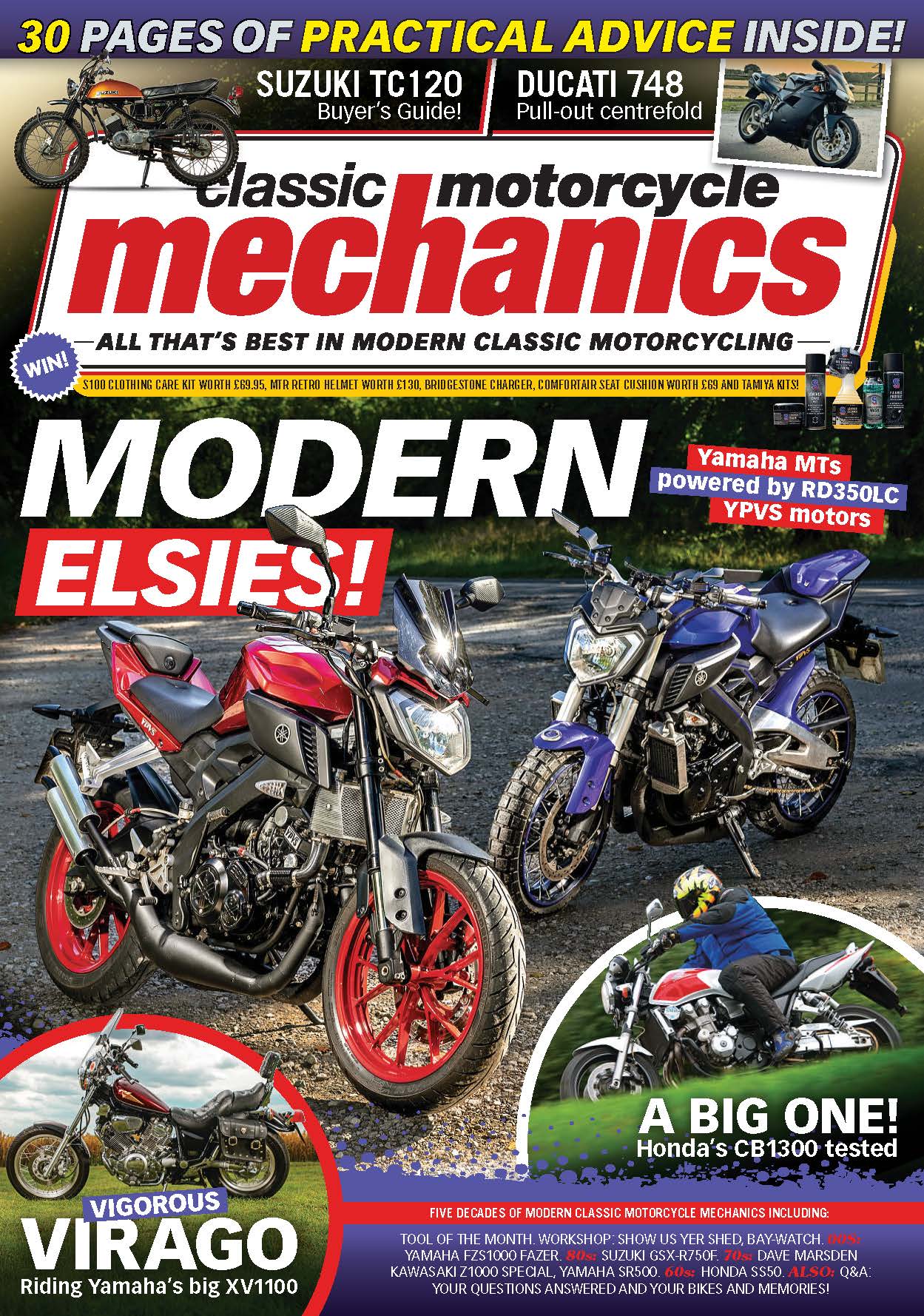Twenty-five years on and still going strong: what is it about Suzuki’s seminal SV650 family that makes them marvellous motorcycles? Read on.
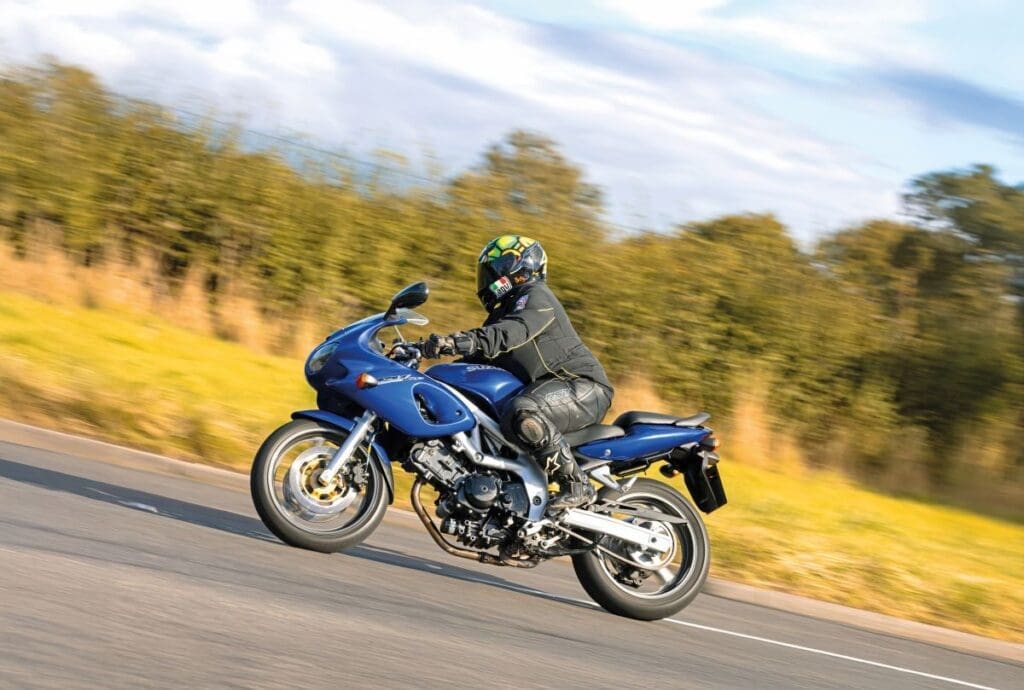
WORDS: BERTIE SIMMONDS
PICS: GARY CHAPMAN, SUZUKI GB, MORTONSARCHIVE, HOLLY SIMMONDS
There’s plenty to be said of Suzuki’s SV650 platform – a tried, tested and well-proven machine of the last quarter-of-a-century.
In fact, I’m probably going to do a reverse road test and come out with the end game right now and instead finish on a ridiculous pun. I’d say Suzuki’s characterful little V-twin is probably the best value-for-money, smile-per-mile, ‘biggest-surprise-in such-a-small-package’ machine that you can get in motorcycling. I’m even going to take the plunge and say it’s been quietly one of the best multipurpose machines out there of the last 50 or more years. People have commuted on them, raced on them, toured on them, and learned their two-wheel trade on them. They have been – and still are – real ‘do-it-all’ bikes.
Now, this comes from a dyed-in-the-wool Yamaha FZS600 Fazer fan: I bought one of those 25 years back. I never really gelled with the Honda Hornet, but always respected the SV650. Having done numerous back-to-back tests against its competitors and contemporaries back in the day and since, I was always more comfy on the larger, four-cylinder Yamaha. And, of course, I wanted more ponies…
But I always realised that this wasn’t an issue for some bikers, most in fact. So, for the last 25 years, when I’ve been asked by people what would be an ideal ‘first bike that doesn’t get boring’ post direct access test, it’s been an easy answer: get an SV650. If they are slightly shorter in the leg: get an SV650. If you want something pretty bulletproof: get an SV650. You want champagne character for Irn Bru outlay: get an SV650…
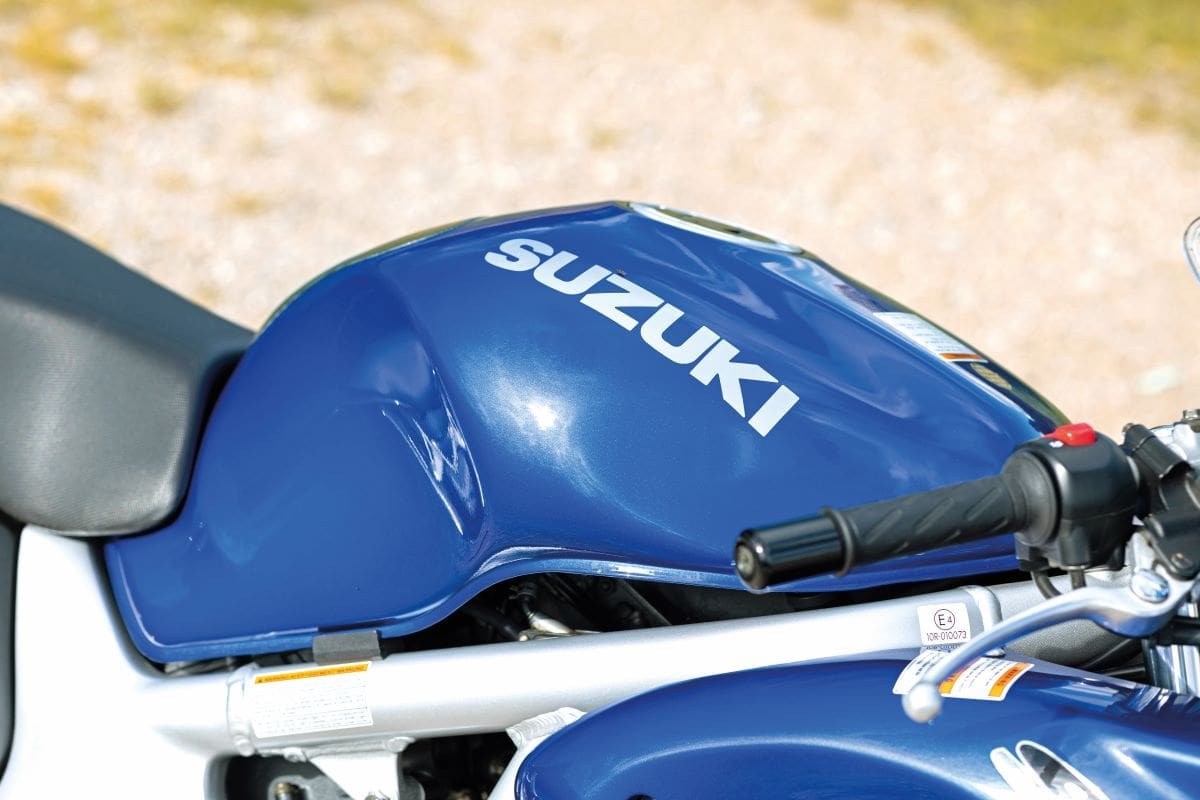
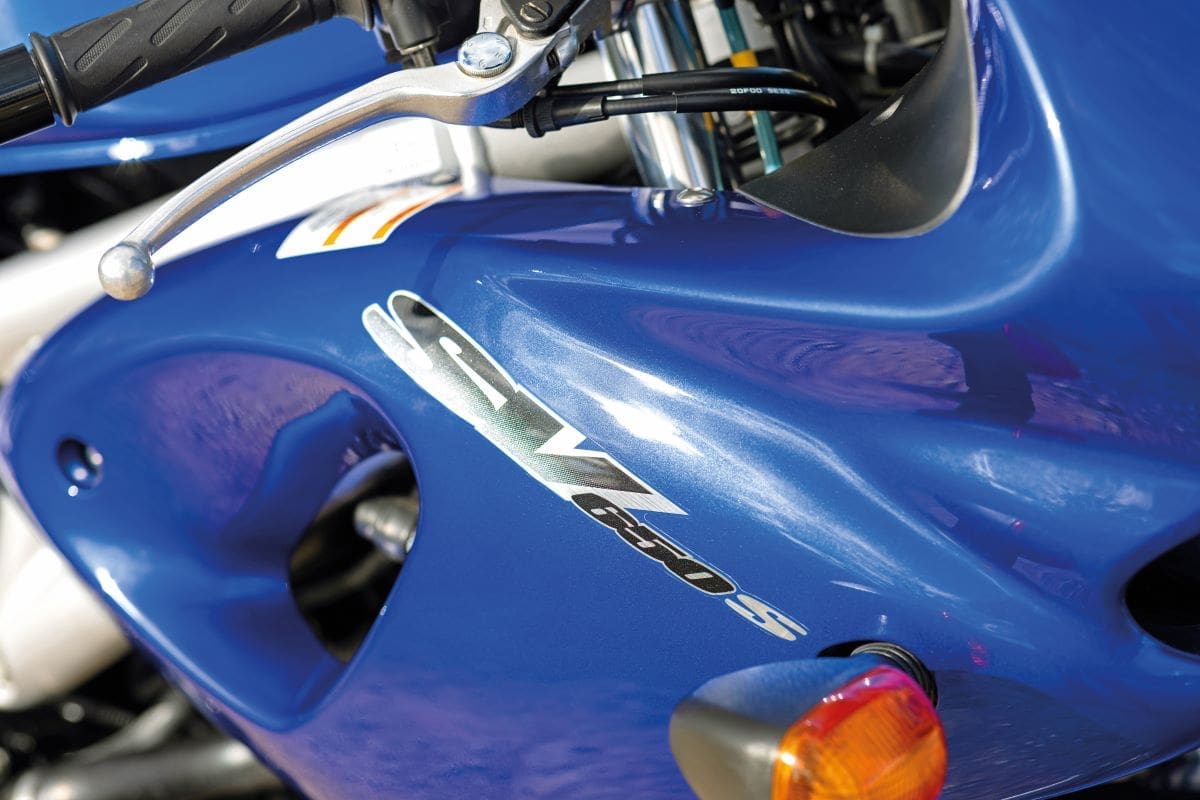
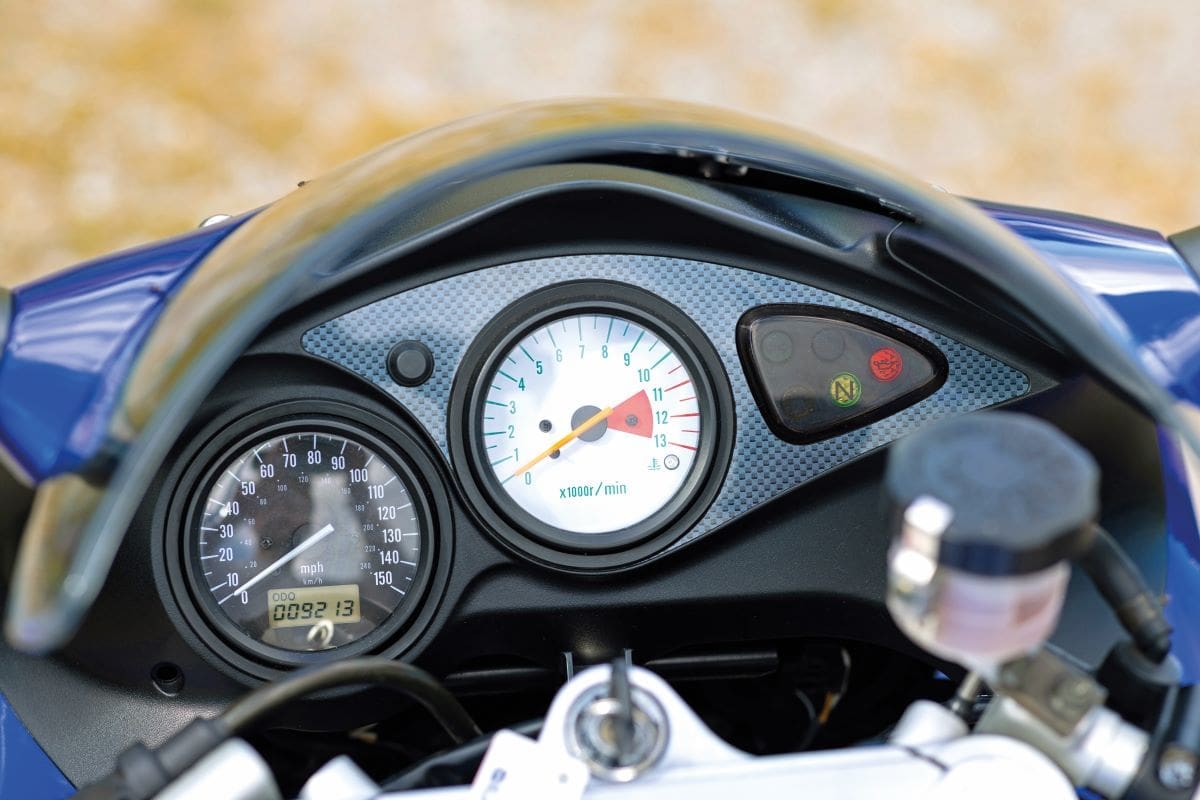
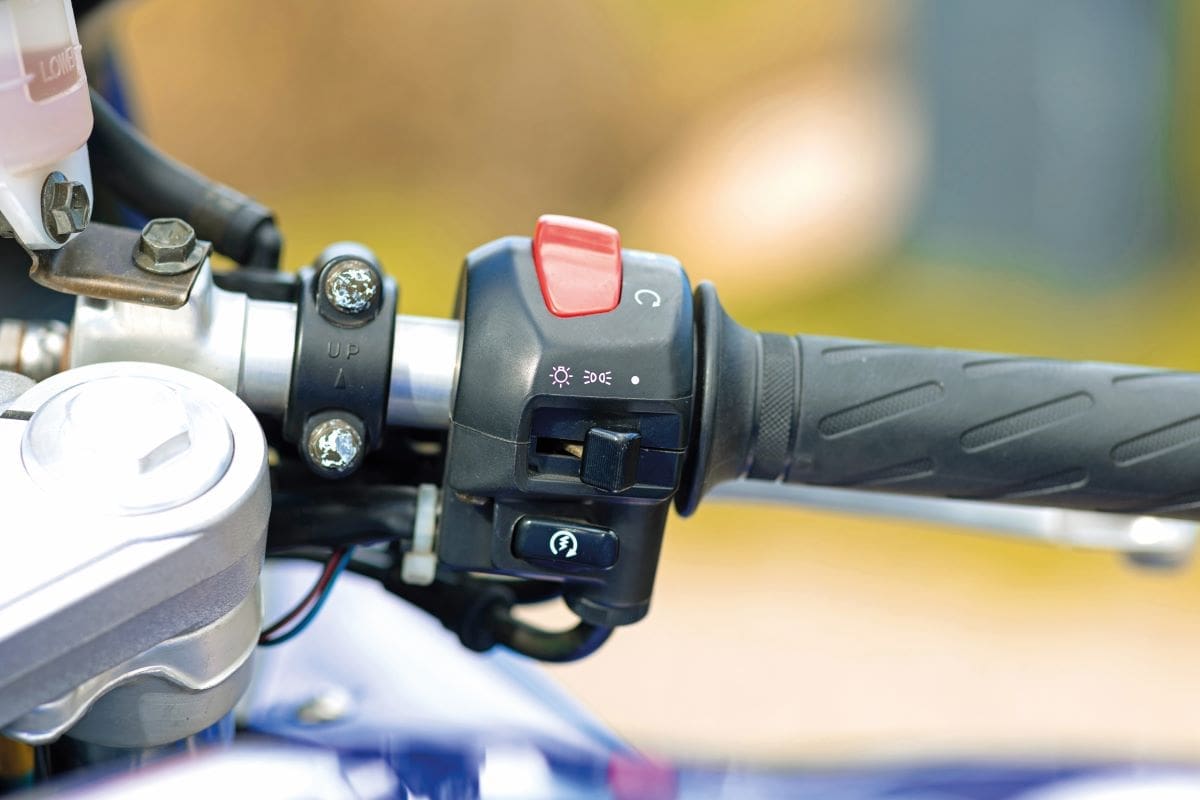
Back in the day
So, best I set my stall out early doors and say why I’m bigging up the Suzuki so much. Well, in 2024 it’s still going strong. That means it’s outlived some amazing machines such as Bandits and Fazers while today’s Hornets are just not the same. Meanwhile, the Suzuki SV650 is still chugging on, with an updated version of the original motor. Suzuki even tried to rename it ‘Gladius’ between 2009-2016 before realising the error of their ways. Once an SV, always an SV…
Cue harp glissando while we go back a few decades… The mid-1990s was a great place to be a biker. Powerful four-cylinder machines everywhere; big V-twins coming into the mainstream with the Japanese manufacturers; and cheap, easy-to-live with middleweight nakeds bringing fun to the masses. Suzuki were on point with their GS600F Bandit series from 1995 using the old four cylinder air-/oil-cooled motor but then when others came on board with their offerings, Suzuki suddenly gave us even more choice with the SV650 V-twins. And (oh the irony) two of them…
The SV650 was the naked, more ‘sit up and beg’-styled version – some of us called it the ‘N’ to help distinguish the two. Equipped with a round headlight, it had a 15-tooth front sprocket and a 45-tooth rear for acceleration, a 33-degree head angle and, of course, more relaxed ergonomics (higher ’bars, pegs lower/further forward.) The SV650S was the half-faired version, having a 15-tooth front and a 44-tooth rear for more top speed and 30 degrees head angle along with 10mm less wheelbase (1420 compared to 1430mm.) At 169 kilos it also was four kilos heavier, thanks to that half-fairing. Launched in early 1999 in Tenerife, the feedback from the press on both bikes was hugely positive, backed by the fact that the N model cost just £4274 on the road and the S a meagre £4574 OTR. A star was well and truly born…
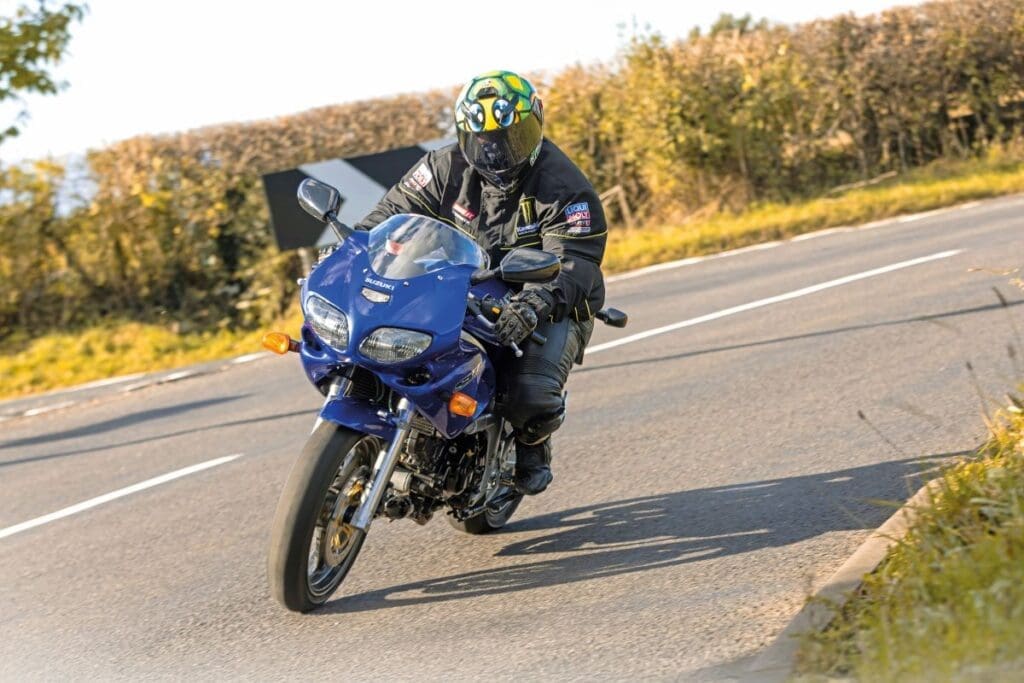
Our test bike here is a T-plate S-model from 1999. For the sports-mad UK of the time, the S model was the one Suzuki GB had more interest in at the NEC show of late 1998, saying at the time that they were bringing in 1200 S models and 800 naked models for 1999. Both bikes, of course, shared the same motor and overall chassis. The motor was a liquid-cooled four-valves-per-cylinder, four-stroke 90-degree V (okay L) twin of 645cc. The cam-chain drives directly from the crank and the front and rear cylinders have different ignition mapping, because Suzuki said the rear cylinder runs slightly hotter. The smaller dimensions of this V-twin over the 1000Smeant that a traditional rear suspension set up could be used – but for budget purposes, both ends were unadjustable. More on that later. Power was around 69bhp at 9000rpm. Everyone was chasing the style leaders Ducati at the time, famed for their lattice/trellis frames, so Yamaha (TRX850), Honda (VTR1000F FireStorm) and Suzuki (TL1000S) were coming up with their own interpretation. Suzuki had made what is best described as an aluminium trellis frame for the TL and followed this style for the SV650. It’s a very attractive frame when you consider that they could have really undersold the SV and gone with something cheap and boring looking.
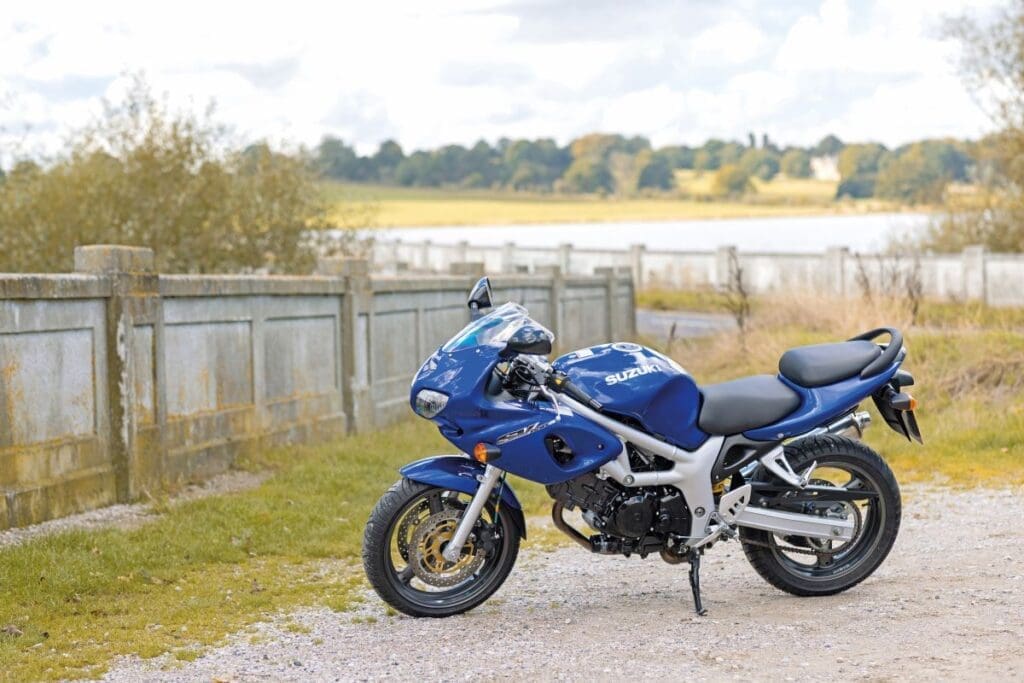
Let’s go ride
With just over 9000 miles on the clocks this SV650S looks stunning for its quarter-of–a-century of life on the road. At first you think the bike is just ‘far away’ but in reality it’s not that large (1130mm high, 740mm wide, seat height 805mm.) You swing a leg over the bike and – if you’re a big fella like me – you’ll be comfy but be wanting just a bit more. Just a bit more space to move around on; perhaps just a bigger tank. Perhaps just some more timber to make the bike feel less like, well, a suppository… Okay, I admit it – a bit more Fazer sized! Talking of timber, the S is 169 kilos dry and the N was 165. I’ve measured them at around 188 kilos wet in the past, so there really isn’t much to them. Moving this S around for pictures is a doddle; it’s an unassuming, unthreatening machine, and perfect for a geriatric’s garage…
And, overall, it’s a comfy place to be and the clocks are as you would expect from a 1990s/2000s middleweight. This means not too much clutter and (on the S) a smart, racy white tacho on the right, set in a saucy background of pseudo carbon-fibre. The left-mounted speedo goes up to 150mph and has an LCD odo/trip with the typical Suzuki mix of five idiot lights clustered on the right. Ahhh… I remember the low fuel light on Suzukis now. Its glow would become stronger the less fuel you had on reserve… Happy days.
More memories: that ‘Suzuki ignition key rattle’ and ‘Pull that clutch in to start’. Don’t forget a little bit of choke, too! Mash the button and the 645cc V-twin farts into life. It’s a fairly muted sound, but that can be sorted easily with an end can – we all did that back in the 1990s. But today we prefer standard, right? Snick her into first and pull away… The bike shouts ‘easy-peasy’ straightaway, from the light action of the slick cable clutch to the positive way you can snick through the gears.
That motor is just a little superstar – like one of those daft terriers you see in the pub. It never stops running around and is never out of energy. And like terriers, they need to be well fed and the SV is nourished from a 16-litre tank (160-mile total range) and those 39mm Mikuni carbs. Who cares if the SV is pumping out 20 fewer ponies than the Fazer or Hornet? The delivery from the motor is smooth for a twin and flexibility is high on the agenda, too.
With the tacho sitting at 3000rpm you’ve still got motive muscle to pull yourself through a corner without going down a gear. But then hit 6000rpm and things start to move faster – keep the bike singing between 8000-9000rpm and you’re going to be in the meat of the torque and into the power, too… It’s quite addictive.
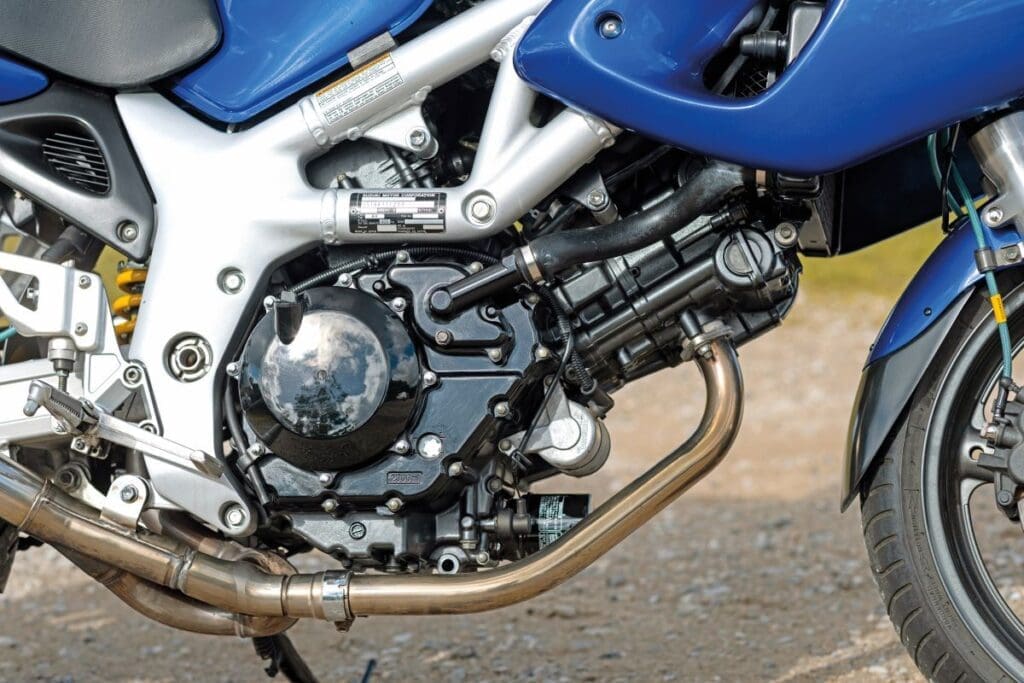
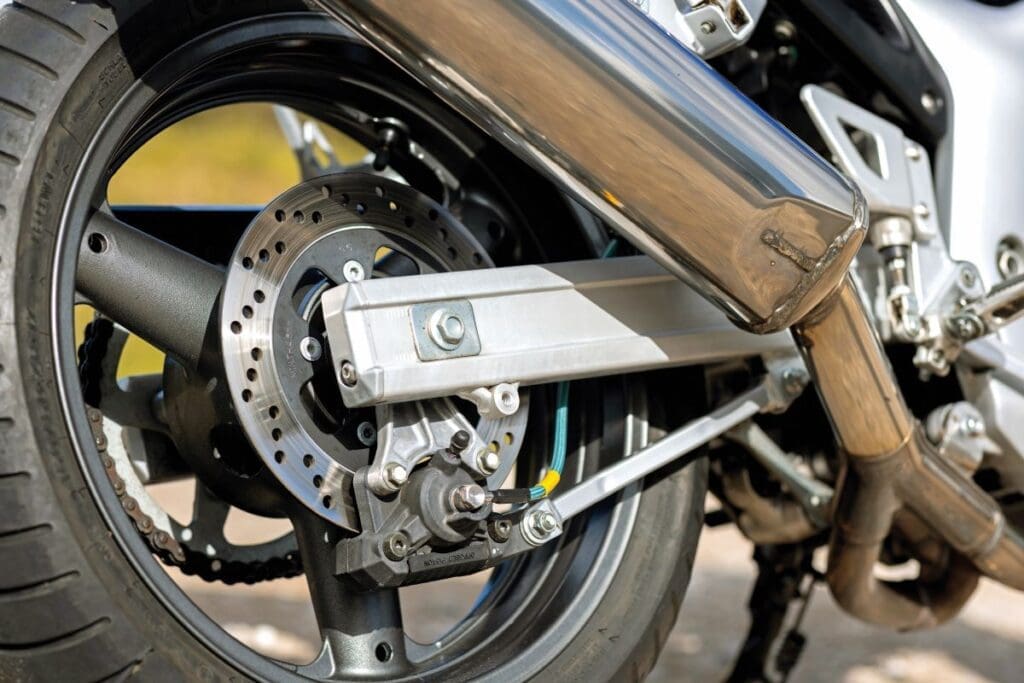
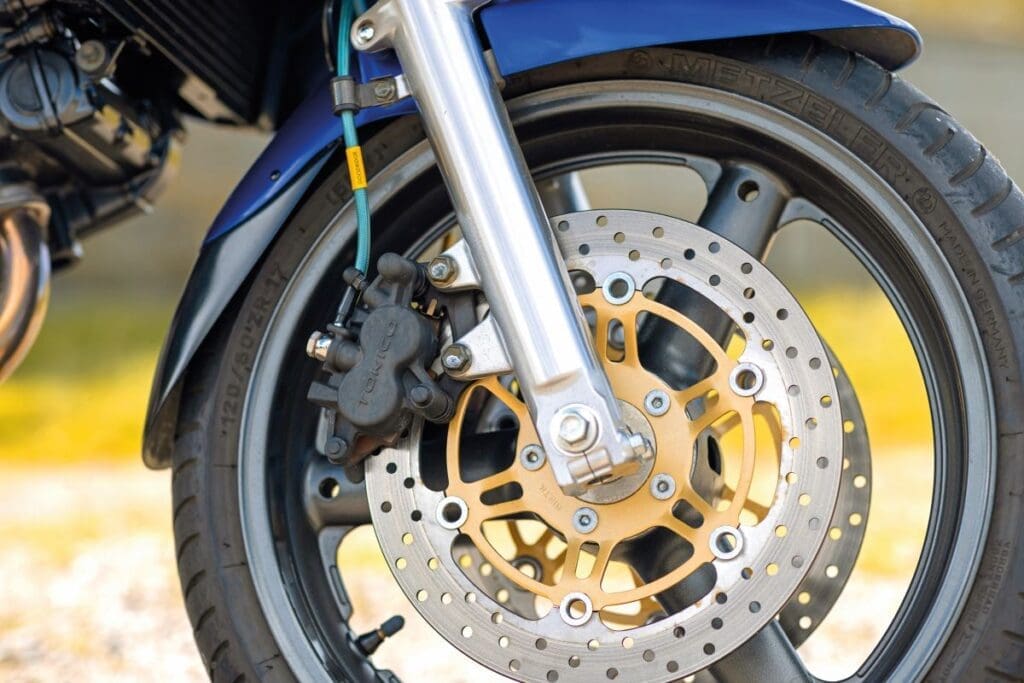
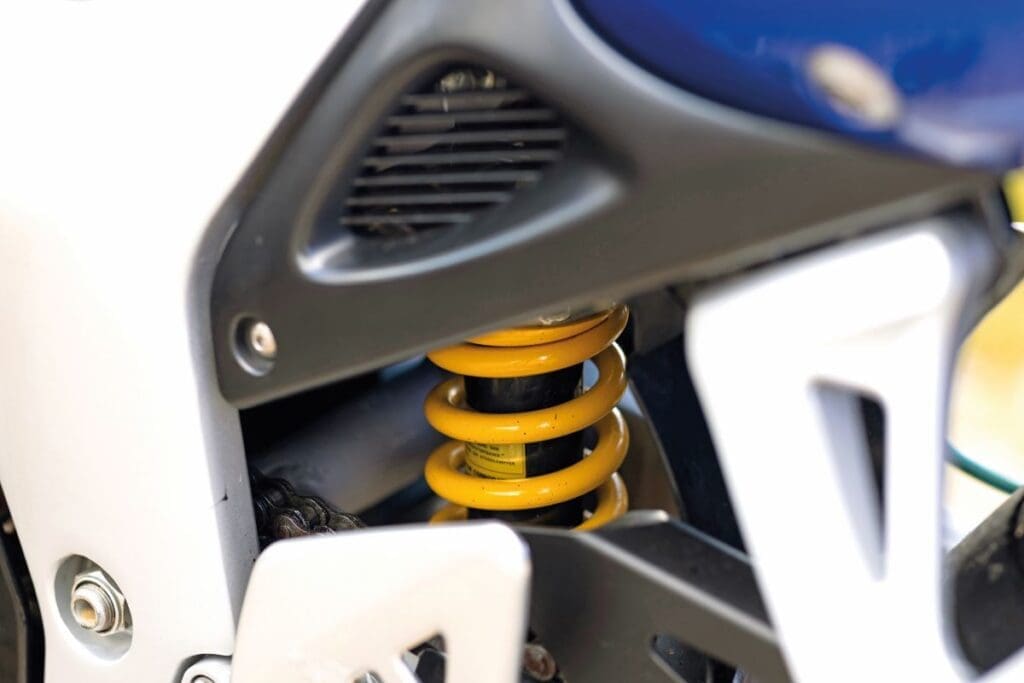
All the while you’re dominating the bike – and you will, whatever your size – you’re reveling in the handling, even on these slightly older tyres. That lack of lard really kicks in here. I know many bikes wet are around the same weight, but bear in mind that (back in’t day) Suzuki’s own Bandit 600 was about 30 kilos heavier and not more powerful. Sprightly? You betcha… Word to the wise time. Suspension was always basic even in 1999. I mean, the 41mm telescopic forks offered zero adjustment and the rear monoshock only gave you a seven-way pre-load adjustment, so even when brand-new we’d muse on what a properly suspended one felt like (I found out in 2004 – see boxout).
Ointment/insect interaction time: the brakes. These always seemed better back in the day, did those little Tokico calipers and 290mm discs. Different pad compounds and braided hoses were always a worthy addition, but that said… from the outset you can see the SV650S is just one of those bikes that is perfectly balanced, almost like the original RD350LC. More power (and yes, bigger anchors) and maybe the bike’s sweet harmonisation would be ruined. It’s got enough power and handling to really give bigger machines a run for their money. It’s just one of those machines that – after riding it – you think, ‘Why would I want more?’
If one person would want more, it would probably be the pillion. So, while there’s a passable impression of a decent seat there and a grab-handle, it’s not the most comfortable compared to the opposition of the time and you will make the handling more relaxed and take the zing out of that motor. A bit. The bike is still capable, but then only pukka tourers shrug off a rear-seater, don’t they?
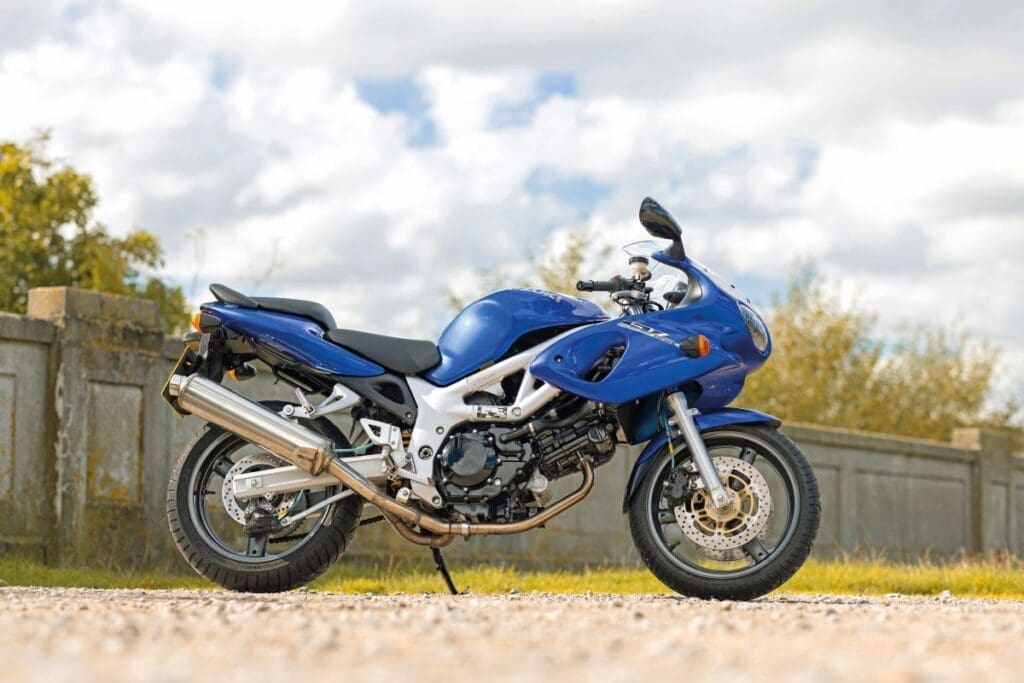
What goes wrong? What should I buy?
I’ve heard of SVs with more than 100k on the clocks. That’s VFR/Pan/BMW territory… Early motors could have loud cam-chains (sticking tensioners/chains), reg-rectifiers go, clutch covers can leak, and early models were recalled to fit an oil-guide plate to prevent premature camshaft wear.
The big bug-bear with a Suzuki of this sort of age (but not this one, it’s a beaut) is that they can easily suffer neglect. The old Suzuki issues of premature exhaust rotting (same as the Bandit/ GS500E), soft wheel paint, engine finish, etc., are all prevalent here, crappy fork lowers, too. Many will have been covered in tat as well, so if you really want to find out what works, you will want to go to the very excellent http://forums.sv650.org to learn what works on them and what doesn’t – fender extenders and bottom fairings are useful in winter.
As to what model/machine we would buy… well, you can find a good, early S for as little as a grand or maybe a bit more with 20k or less on the clocks.That’s a ruddy steal, I tell ya. Meanwhile, basket case projects can go for just a few hundred quid. While I’m a Fazer man, I’d go for the post-2003 upgrade model. For some, the smooth aesthetics of the original S were considered ‘less than masculine’ which is fine for half the population. I did prefer the later model’s angular styling, à la SV1000S, as well as the improvements and extra power. These start for as little as £1400 and you’d find a really nice one for under two grand.
Ending with a pun…
So, with many bikes about suitable for any pocket and with 25 years of good, solid service behind the model itself, there’s really nothing stopping you buying a decent SV. I’m keeping an eye on eBay right now to find one for my frail dotage.
It has to be said here that there just seems to be something about a 650-ish twin that hits that sweet spot in motorcycling. Think of it: be it the old BSA A65, a clutch of Japanese parallel and V-twins and even the retro Royal Enfield range. Let it be said that Suzuki’s SV650 is pretty much the best of them all. If you’re recommending a bike to a nipper upsizing from a 125 post-test for their salad days or to a biker downsizing as they get older, ‘lettuce’ just say this: the Suzuki SV650 is a ‘little gem’ of a motorcycle. Sorry…
■ THANKS TO: Pirelli for supplying some Angel GT IIs. You’ll be seeing how they get on when Andy Bolas (proud owner) gets the bike even more shipshape in future issues of CMM.
Still going strong…
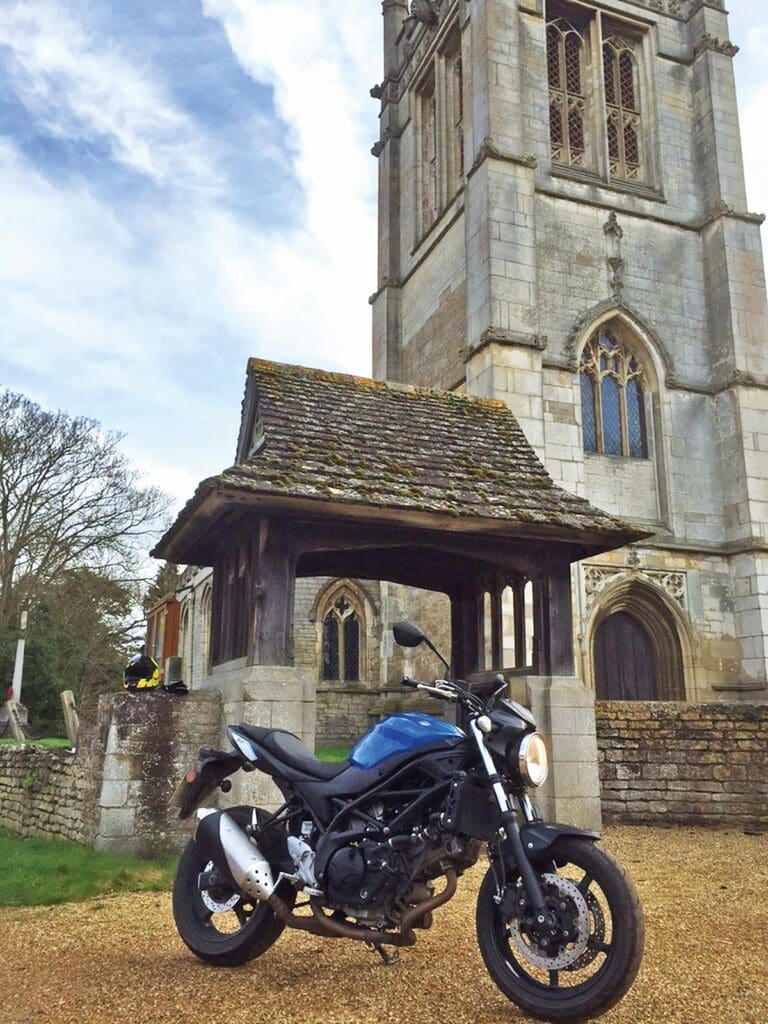
Today’s brand-new Suzuki SV650 costs £7399 new and back in 2017 I got the chance to ride the-then ‘new’ one, which is the current version. What’s changed? Even the 2017 bike had the ‘ignition key rattle’ until it started to work, but when you threw a leg over her, the SV was as
svelte as ever. No need to pull the clutch in to start now, but the clutch is still light and the gearbox delightful.
Trundling around at slow speed is even more of a doddle with not a hint of snatchiness when you change up or down: you still naturally feel at home on the SV and it’s about as close to riding a pair of favourite slippers as you can get. Checking the spec – just perhaps – this is ‘Low Speed Assist’ in action, where the SV’s brain cleverly gives you a flick of rpm as you engage the clutch. Wind that throttle up when the road opens out and you’re rewarded with a really saucy engine note – perhaps more so than on the older model which becomes a demonic howl as you go into
7000rpm. Who would have thought the SV could be capable of such a lovely racket, even if you’re not quite near the 10,500rpm readline. Chassis-wise, the SV seems as nimble as ever, Okay, it’s not super-light at just under 200 kilos, but for some reason SVs always feel it.
There’s got to be a disappointment and for me it’s when I’m asking for the anchors. The four-pot Tokicos are marginal and (if I’m being cruel) bordering on poor – the bike I used had been used in all weathers, so maybe they needed a clean? Whatever, even this model of SV – which you can now nab for as little as £3000 – can still raise a smile.
Suzuki SV650 racing
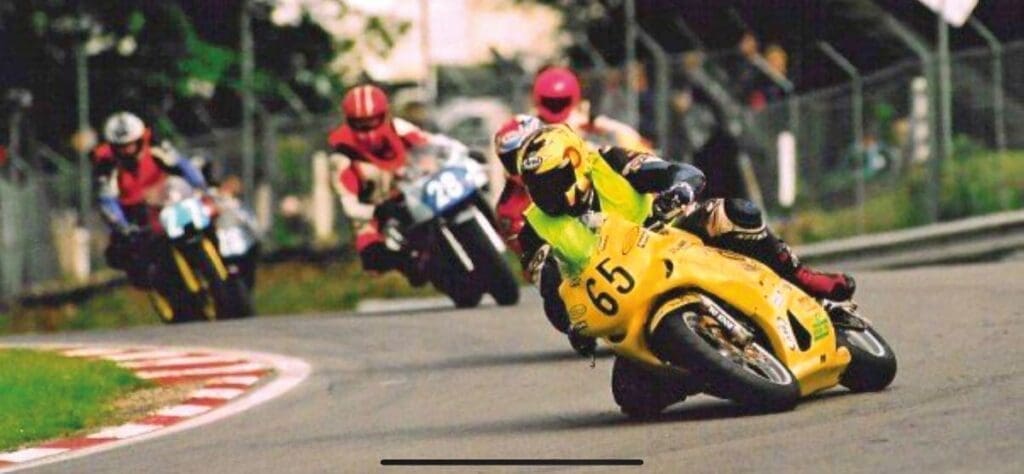
With a nimble chassis and punchy motor, there is little wonder the SV650S made the basis for a really good little race bike.
Back in 2004 I raced a motorcycle for one single weekend in four races in the very popular MiniTwins series. Everyone on the magazine I worked
for had to do a round of the series and I ended up at my ‘local’ (being from Kent) Brands Hatch circuit.
Changes to the bike were simply a different pipe (we had an Akrapovic) and suspension (new fork internals and Ohlins rear shock.) No MiniTwin was above 72bhp and they often raced on track with the 400cc
Supersport machines in the overspill races. It was an amazing experience. Back then I did many more miles, did lots of track days, and was on many track launches. So, I thought I was fairly sharp. Even so, as a novice I wore a hi-viz vest and was amazed at how quick the regulars were!
Starting 33rd from 35 starters in the 400cc four-cylinder/650 twin overspill races, I was going to be happy with a 34th finish overall. I can only guess that lining up for the first time is like going into combat: you’re scared but then you realise you’re there and there’s nothing else for it.
Go for it… Result in race one I was 20th out of 35 starters (I actually blubbed coming over the finish line at the end of the nine laps, it was that emotional) and about 5th in my class (of 12 MiniTwins.) With two races on Saturday and two on Sunday I’d soon reach my level and start banging fairings with those in the middle of the field. I managed a best of fourth in class and 13th out of 35 bikes all told. I think my best time on the SV was a 55.5s lap of Brands Indy.
The little SV was a brilliant little race bike and they’re still being raced today. Acknowledged expert race SV fettlers are: www.jhsracing.co.uk and they can help give you a very compliant road bike, too…


